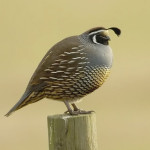Born to Run: California Valley Quail
By Paul Stein
Imagine a bird with an identity crisis. Surely it would be the California quail. Even though quite capable of flying, in most cases this colorful bird has forsaken this magnificent talent in favor of running. Why remain grounded when the world of flight offers such rich possibilities? The answer lies in the woodland chaparral the quail occupies—a habitat rich in food, cover, and security.
The California quail, or valley quail, is a plump, short-tailed bird with gray and brown plumage; a prominent  teardrop-shaped head plume or double plume is present in both sexes. Quail are birds from the order Galliformes, which are comprised of heavy-bodied ground-feeding birds which includes turkey, grouse, chicken, ptarmigan, partridge and pheasant. The name derives from “gallus,” Latin for “cock” or “rooster.” Galliformes are important seed dispersers and predators in the ecosystems they inhabit, and are often reared as game birds for their meat and eggs and for recreational hunting.
teardrop-shaped head plume or double plume is present in both sexes. Quail are birds from the order Galliformes, which are comprised of heavy-bodied ground-feeding birds which includes turkey, grouse, chicken, ptarmigan, partridge and pheasant. The name derives from “gallus,” Latin for “cock” or “rooster.” Galliformes are important seed dispersers and predators in the ecosystems they inhabit, and are often reared as game birds for their meat and eggs and for recreational hunting.
Gallinaceous birds are arboreal or terrestrial animals and highly skilled runners. Many prefer not to fly at all, but instead walk and run for locomotion and escape predators by running rather than flying.
Males of most quail species are more colorful than females and have elaborate courtship behaviors that include strutting, fluffing of tail or head feathers, and vocal sounds. They live from 5–8 years in the wild and up to 30 years in captivity. Quail can be found worldwide and in a variety of habitats, including forests, deserts, and grassland. All quail use visual displays and vocalizations for communication, courtship, fighting, territoriality, and brooding.
The California legislature designated the California valley quail (Callipepla Californicus) as the official state bird in 1931. Known for their hardiness and adaptability, this native bird is smaller than a pigeon, sports the distinctive black plume on its head and a black bib with a white stripe under its beak. Other common names for this sartorial bird include: California partridge, Catalina quail, and Topknot quail.
California quail, common year-round residents in Calaveras County, live near open woodlands and brushy areas along permanent water sources. Although this bird coexists well at the edges of urban areas, its population is declining in some areas as human populations increase. Originally found mainly in the southwestern United States, they have been introduced into other areas including British Columbia, Hawaii, Chile, New Zealand and Australia. Since 1960, the overall population has diminished in North America.
The voice call of the California quail is an emphatic chi-ca-go with three distinct syllables. A variety of grunts and sharp cackles are also made. Along with the social “chicago” call, they have a variety of vocalizations including contact and warning “pips.” During the breeding season, males utter the agonistic “squill” and will often interrupt their social mate’s “chicago” call with a “squill.”
The California quail, like most Galliformes, is a highly social bird that often gathers in small flocks known as “coveys”. In morning and evening they forage beneath shrubs or on open ground near cover. They usually travel in groups. Their flight is explosive but lasts just long enough to reach cover. During winter the California quail lives in coveys of 10 to 200 birds and will stay in these flocks until they pair off during mating season. The California quail will roost in trees to avoid danger and rest, and males often perch on a tree or post to call out and mark their territory.
The nesting behavior of California quail is also typical of most gallinaceous birds. The females lay between 12-16 cream and brown speckled eggs in a nest scraped in the ground beneath a shrub or other cover. Incubation lasts about three weeks and both parents care for the chicks, which leave the nest shortly after birth. Chicks make their first attempts at flight at about 10 days old. They remain on the ground for about a month and then roost in trees with the rest of the flock. Often, families group together, into multifamily “communal broods” which include at least two females, multiple males, and many offspring. Males associated with families are not always the genetic fathers. In good years, females will lay more than one clutch, leaving the hatched young with the associated male and laying a new clutch, often with a different associated male.
These birds forage on the ground, often scratching at the soil. They can sometimes be seen feeding at the sides of roads. Their diet consists mainly of seeds and leaves, but they also eat some berries and insects. If startled, these birds explode into short rapid flight, called “flushing.” Given a choice, they will normally escape on foot, which is quizzical, as the ability of flight seems far superior to what can be achieved on foot. Indeed the independent ability to fly has been coveted by mankind for eons, but it seems that the California valley quail just don’t know how good they have it!
Paul Stein is a biologist with a long career in aquaculture. He was formerly chief deputy director of the California Department of Fish & Wildlife. He can be reached at [email protected]



